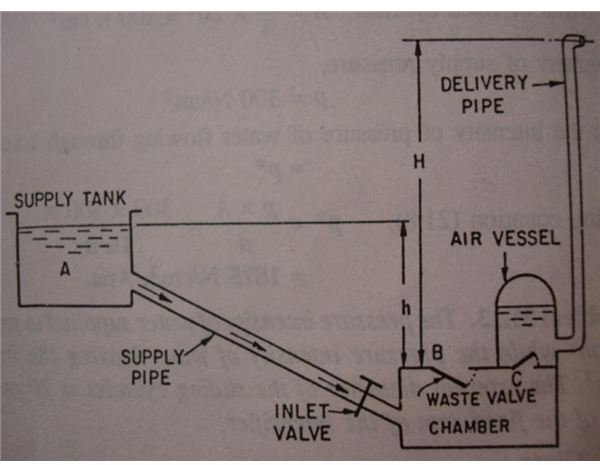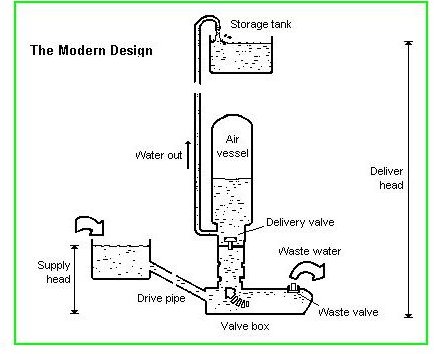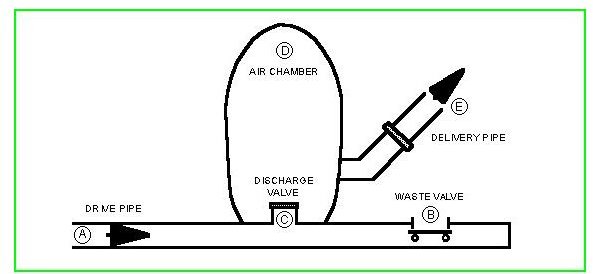Hydraulic Ram Pumps - How They Work and are Used
Introduction
The entire world is thinking “green” before doing anything and everything. Saving electricity is the first step towards going green. The celebration of “Earth Hour” over the entire planet is the best evidence towards saving electricity and thereby reducing Green house gases. There is also a great pressure on automobile manufacturers for finding an alternate fuelled vehicle. One such attempt at going green is using methods that employ simple science to do our everyday household work. In this article, we will discuss the hydraulic ram pump, which does not require a power source and does not have any moving parts in it.
Working and System Description
The hydraulic ram is a pump which raises water without any external power for its operation. One essential requirement for the satisfactory operation ofa hydraulic ram is the availability of a large quantity of water with a small positive head or height. This large quantity of water at a small height is sufficient to lift small quantity of water to a greater height. It works on the principle of “Water Hammer.”

The system has a chamber with two flap valves and an air vessel. This chamber is connected to the water supply from a supply tank or a water reservoir at a small height. The supply tank and the pumping chamber are separated by a valve which controls the flow of water.

When the inlet valve fitted on the supply line is opened, water starts flowing from the supply tank to the pumping chamber. The chamber has two valves, “B” and “C.” Valve “B” is the waste valve and “C” is called the delivery valve. The valve “C” is fitted to an air vessel. As water is flowing from the supply tank, the chamber gets filled up and valve “B” starts to move upwards. A moment comes, when the valve “B” suddenly closes. This sudden closure of valve “B” creates high pressure inside the chamber. This sudden increase in pressure opens “C” which is the delivery valve. Thus the water from the chamber enters the air vessel and compresses the air inside the vessel. The compressed air exerts a force on water which is inside the air vessel. Thus a small quantity of water is raised to a greater height. As the water in the chamber looses momentum, the waste valve “B” gradually opens in downward direction and flow of water from the supply tank starts flowing to the chamber and the cycle will be repeated.

Advantages and Disadvantages

Advantages:
- No moving parts,
- No power requirements,
- Inexpensive,
- Quiet pumping continuously over a long period,
- Pollution free or “Green” pump,
- Simple construction and easy to install, and
- Only initial cost and very low or negligible maintenance cost.
Disadvantages:
- It can pump only one tenth of the received water volume remaining being wasted through waste valve,
- It must have a continuous source of supply at a minimum height of not less than 3 feet or 91 cm.
- It cannot pump viscous fluids to a greater height. Usually used for pumping drinking water or potable water.
Efficiency:
Let
W = weight of water flowing per second into the chamber,
w = weight of water raised per second,
h = height of water in supply tank above the chamber,
H = height of water raised from the chamber.
The energy supplied by the supply tank to the ram
= weight of water supplied * Height from which the water is supplied.
= W * h.
Energy delivered by the ram
= Weight of water raised * height through which water is raised.
= w * H.
Thus efficiency = energy delivered by the ram/ energy supplied to the ram
η = w * H/ W * h.
The efficiency η, specified above is called as D’ Aubuisson’s efficiency.
Rankine gave another form of efficiency as he considered that the weight of water raised is not H, but it is (H-h).
Thus Rankine efficiency η = w * (H-h)/ (W-w)* h.
Reference:
A Text book of Hydraulics and Fluid mechanics by R.K.Bansal.
howstuffworks website.
